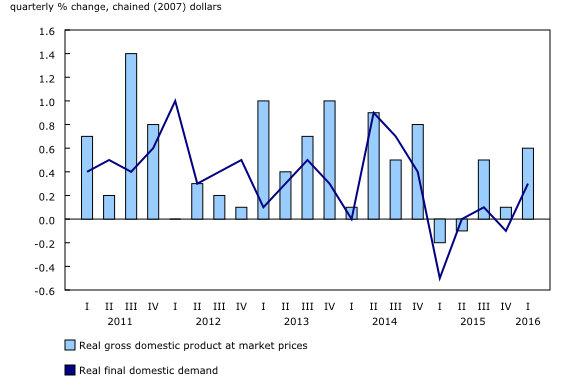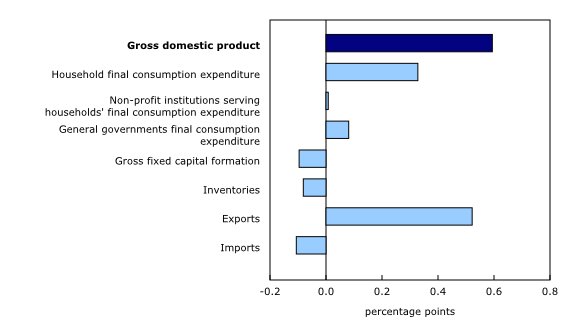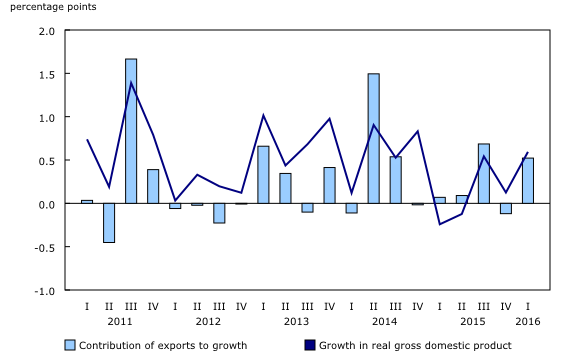Gross domestic product, income and expenditure, first quarter 2016
Archived Content
Information identified as archived is provided for reference, research or recordkeeping purposes. It is not subject to the Government of Canada Web Standards and has not been altered or updated since it was archived. Please "contact us" to request a format other than those available.
Released: 2016-05-31
Real gross domestic product (GDP) grew 0.6% in the first quarter, following an increase of 0.1% in the fourth quarter of 2015.
Exports were the largest contributor to real GDP growth in the first quarter, up 1.7% following a 0.4% decline in the previous quarter. The volume of exports of goods increased 1.9%, while that of services advanced 0.7%. Imports were up 0.3%.
Final domestic demand was up 0.3%, after edging down 0.1% in the previous quarter.
Business non-residential investment fell 2.5%, the fifth consecutive quarterly decline, driven by lower investment in engineering structures (-4.3%).
Housing investment was up 2.7% in the first quarter, with increases in new home construction, renovations and resale activity. Household final consumption expenditure rose 0.6%, with increased outlays on goods (+1.1%) and services (+0.2%).
Businesses drew down inventories by a further $7.0 billion, after a $5.6 billion withdrawal in the previous quarter. The stock-to-sales ratio edged down.
Government final consumption expenditure increased 0.4% in the first quarter.
Expressed at an annualized rate, real GDP rose 2.4% in the first quarter. By comparison, real GDP in the United States grew 0.8%.
Volume of exports rises
Real exports of goods and services posted a 1.7% gain in the first quarter, following a decline of 0.4% in the fourth quarter of 2015. Although the volume of exports increased, their value in nominal terms decreased 0.8%, largely because of price declines in the energy sector. The resulting decline in export-related earnings was reflected in lower gross operating surplus of non-financial corporations (-1.3%).
Exports of goods were up 1.9%, following a 0.6% decline in the previous quarter. Motor vehicles and parts (+7.3%) were the main contributor, marking a fourth consecutive quarter of growth. Notable increases were also recorded in basic and industrial chemical, plastic and rubber products (+6.1%) and forestry products and building and packaging materials (+4.5%). Offsetting these increases were international shipments of metal ores and non-metallic minerals, which fell 10.0%.
Exports of services grew 0.7%, owing largely to gains in travel services, which increased 3.2% following three quarters of contraction.
Investment in housing strengthens
Growth in business investment in residential structures accelerated to 2.7% in the first quarter, the fifth consecutive quarterly increase. Business investment in new housing construction increased 2.9%, after a 0.7% decrease in the fourth quarter of 2015. Ownership transfer costs (+5.8%), which reflect movement in the resale market, and renovations (+0.6%) were both up for the second consecutive quarter.
Household consumption increases
Household final consumption expenditure increased 0.6% in the first quarter, following a 0.5% gain in the fourth quarter of 2015. Outlays on goods grew 1.1%, as semi-durable goods (+1.9%), durable goods (+1.1%) and non-durable goods (+0.8%) all rose. Outlays on services increased 0.2%.
Expenditures on transport advanced 1.2%, as spending associated with the operation of transport equipment, such as gasoline, repairs and other vehicle expenses, rose 1.8%. Clothing and footwear expenses increased 2.8%, while spending on electricity, natural gas, propane and other fuels decreased 1.4%, partly as a result of unseasonably warm weather in some parts of the country.
Spending on insurance and financial services was up 0.8% for the quarter.
Expenditures by Canadians abroad fell 4.3%, influenced by a depreciation in the exchange rate relative to the US dollar.
Further declines in business investment
Investment in non-residential structures decreased 3.7%, continuing the downward trend seen over the previous five quarters. Lower investment in engineering structures (-4.3%) largely contributed to the decline in the first quarter, due to weakened investment activity in the oil and gas sector, which was affected by lower oil prices. Business investment in non-residential buildings (-1.9%) also continued to fall.
Business outlays on machinery and equipment fell 0.7%, in tandem with decreasing imports. This was the fifth consecutive quarterly decline, with aircraft and other transportation equipment (-13.7%) and industrial machinery and equipment (-1.9%) leading the decrease.
Business investment in intellectual property products was down 1.4%, as software fell 1.8% and research and development dropped 1.2%. Mineral exploration investment edged down 0.1%, following larger declines throughout 2015.
Business inventories drawn down
Non-farm inventories were reduced by a further $7.2 billion in the first quarter, after a withdrawal of $4.8 billion in the previous quarter. This resulted mainly from a continued drawdown in motor vehicle inventories. Farm inventories were reduced for a ninth consecutive quarter.
Retailers' inventories of durable goods declined $3.4 billion, mainly as a result of lower stocks of motor vehicles (-$2.5 billion). Wholesalers' inventories of non-durable goods were up $1.7 billion in the first quarter. Manufacturers' inventories of non-durable goods increased $2.3 billion.
The economy-wide stock-to-sales ratio edged down in the first quarter.
Real gross national income declines
Real gross national income, a measure of the purchasing power of productive income earned by Canadian residents, retreated 0.4%, following a flat fourth quarter.
Export prices fell 2.5%, while import prices declined at a slower rate (-0.4%), resulting in weakened terms of trade. The price of final domestic demand rose 0.3%, while the GDP implicit price index, representing the overall price of goods and services produced in Canada, declined 0.3% in the first quarter, pulled down by price declines in oil and natural gas.
Household disposable income advances
Household disposable income increased 0.6% (nominal terms) in the first quarter. Compensation of employees rose 0.4%, as a result of increases in both wages and salaries (+0.4%) and employers' social contributions (+0.5%). Transfers received by households rose 0.7%, owing mainly to social security benefits and Employment Insurance benefits, while transfers paid by households fell 0.4%, owing to lower transfers to financial corporations.
Household final consumption expenditure (+0.7%) increased at a slightly faster pace than disposable income. The household saving rate was 3.9% in the first quarter.
The household debt service ratio (defined as household mortgage and non-mortgage payments divided by disposable income) edged down from 14.05% to 14.04%, as both income and obligated payments increased at almost the same rate.
Note to readers
For information on seasonal adjustment, see Seasonally adjusted data – Frequently asked questions.
Percentage changes for expenditure-based statistics (such as personal expenditures, investment, exports and imports) are calculated from volume measures that are adjusted for price variations. Percentage changes for income-based and flow-of-funds statistics (such as labour income, corporate profits, mortgage borrowing and total funds raised) are calculated from nominal values; that is, they are not adjusted for price variations.
There are two ways of expressing growth rates for gross domestic product (GDP) and other time series found in this release.
- Unless otherwise stated, the growth rates in this release represent the percentage change in the series from one quarter to the next, such as from the fourth quarter of 2015 to the first quarter of 2016.
- Quarterly growth can be expressed at an annual rate by using a compound growth formula, similar to the way in which a monthly interest rate can be expressed at an annual rate. Expressing growth at an annual rate facilitates comparisons with official GDP statistics from the United States. Both the quarterly growth rate and the annualized quarterly growth rate should be interpreted as an indication of the latest trend in GDP.
Revisions
Data on GDP for the first quarter of 2016 were released along with revised data for the first, second, third and fourth quarters of 2015. These data incorporate new and revised data, as well as updated data on seasonal trends.
Real-time CANSIM tables
Real-time CANSIM tables 380-8063 and 380-8064 will be updated on June 7. For more information, consult the document, Real-time CANSIM tables.
Next release
Data on GDP by income and expenditure for the second quarter will be released on August 31.
Products
The System of Macroeconomic Accounts module, accessible from the Browse by key resource module of our website, features an up-to-date portrait of national and provincial economies and their structure.
The Methodological Guide: Canadian System of Macroeconomic Accounts (13-607-X) is now available from the Browse by key resource module of our website, under Publications.
The User Guide: Canadian System of Macroeconomic Accounts (13-606-G) is now available from the Browse by key resource module of our website, under Publications. This publication will be updated to maintain its relevance.
Contact information
For more information, or to enquire about the concepts, methods or data quality of this release, contact us (toll-free 1-800-263-1136; 514-283-8300; STATCAN.infostats-infostats.STATCAN@canada.ca) or Media Relations (613-951-4636; STATCAN.mediahotline-ligneinfomedias.STATCAN@canada.ca).
- Date modified:





